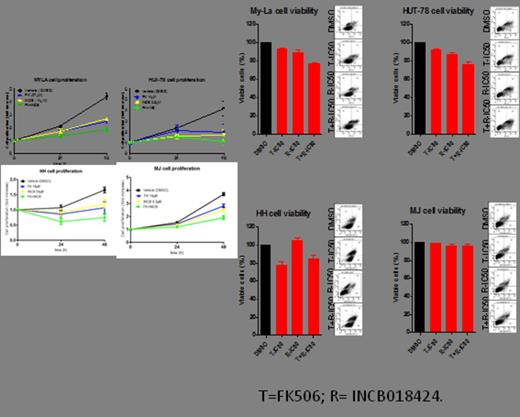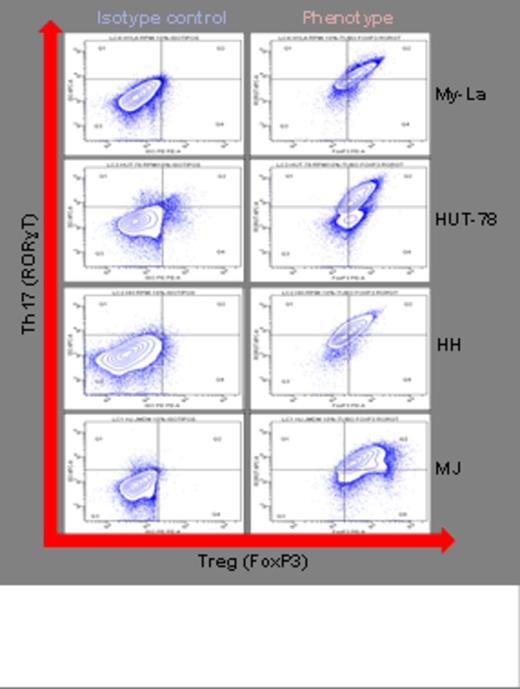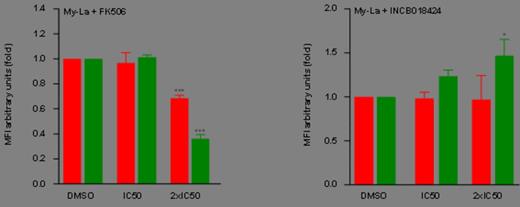Abstract
Development of targeted therapy for Cutaneous T-Cell Lymphoma (CTCL) patients still requires actionable mutated genes and deregulated pathways to be identified and explored. Although it has been proposed that neoplastic CTCL cells feature increased TCR downstream signaling and also a degree of phenotypic plasticity, the mechanistic nature of the pathogenesis of this disease remains essentially unveiled. Our laboratory has recently studied the mutational status of a number of human CTCL lesions, and detected TCR/PLCG1 and JAK/STAT signaling pathways frequently mutated. Taking advantage of these findings, we have explored the biological effects that targeted inhibition, using specific inhibitors of the two afore mentioned signaling pathways, exerts in proliferation, survival and phenotype in a panel of human CTCL cell lines. Our results suggest that TCR/PLCG1 and JAK/STAT pathways can control proliferation, survival and phenotype of CTCL cells and hence can serve as potential targets for mono or combinatorial therapy in CTCL patients.
Cutaneous T-cell lymphoma cell lines used were HH (MF) and MJ (MF) obtained from ATCC (Rockville, MD, US ) and My-La (MF) and HUT-78 (SS) obtained from ECACC (Salisbury, UK).Cell proliferation analyses were performed using CellTiter-Glo® Luminescent Cell Viability Assay kit (Promega, Madison, WI, USA) with the appropriate amount of inhibitor. Apoptosis were evaluated by flow cytometry using FlowCellect Annexin Red Kit (EMD Millipore Corporation, Billerica, USA). All data were detected on a FACS Calibur flow cytometer (BD) and analyzed using CellQuest Pro software (BD). Treg/Th17 phenotype was determined by flow cytometry. Cells were stained with monoclonal antibodies: anti-CD4-allophycocyanin (APC)-Cy7 (clone SK3, Becton Dickinson, San Diego, CA). Monoclonal antibodies to detect intracellular antigens were: anti-Foxp3-PE (clone PCH101, eBiosciences, San Diego, CA), anti-RORgt-APC (clone AFKJS-9, eBioscience, San Diego, CA), and IgG2a isotype controls conjugated with PE and APC. The cells were acquired by flow cytometer (FACS Canto-II, Becton Dickinson).
To test both the effect that inhibition of PLCG1 downstream signaling and the effect that inhibition of JAK downstream signaling provokes in CTCL cell lines, they were incubated with increasing concentrations of specific CaN and JAK inhibitors like FK506 and INCB018424 respectively or DMSO (vehicle) for 0, 24 and 48 h. The results show that increasing concentrations of FK506 affected the proliferation and survival of CTCL cells in a concentration dependent manner. But in the case of INCB018424 inhibitor mainly affects CTCL cell proliferation versus survival. The combined use of FK506 and INCB018424 produced a significant greater inhibition of CTCL cell proliferation than each inhibitor alone except of HUT-78, where the combined treatment was not significant (Figure 1).
Because of neoplastic T-cells can acquire Treg and/or Th17 phenotypes at different stages of the disease (Tiemessen, M.M. et al. 2006) and that there is a CTCL phenotypic plasticity(Abraham, Zhang et al. 2011) (Eisenstein and Williams 2009) (Hoechst, Gamrekelashvili et al. 2011), we have decided to study these phenotypes in the four CTCL cell lines. Strikingly we found that most cells in all CTCL cell lines were double positive for the expression of Treg and Th17 markers (Figure 2).
The expression of the Treg and Th17 lineage markers (FoxP3 and RORγt respectively) after treatment with FK506 and INCB018424 were tested. FK506 provoked an unbalance in the expression of the Treg and Th17 markers in all CTCL cell lines. (Figure 3).
These results are the first evidences for the use of a combinatorial targeted therapy developed on the basis of a mutational analysis in CTCL, which in the future may serve as a lead to explore into detail about a potential utilization of this therapeutical approach in the clinic. Surprisingly, our results evidence a novel hybrid Treg/Th17 phenotype in our panel of CTCL cell lines, that we could alter by interfering specifically with TCR/PLCG1 and/or JAK/STAT downstream signaling using FK506 and/or INCB018424 respectively. Although these are still primary results, it will be important to explore how to take clinical advantage of these phenotypic characteristics in patients.
No relevant conflicts of interest to declare.
Author notes
Asterisk with author names denotes non-ASH members.




This feature is available to Subscribers Only
Sign In or Create an Account Close Modal